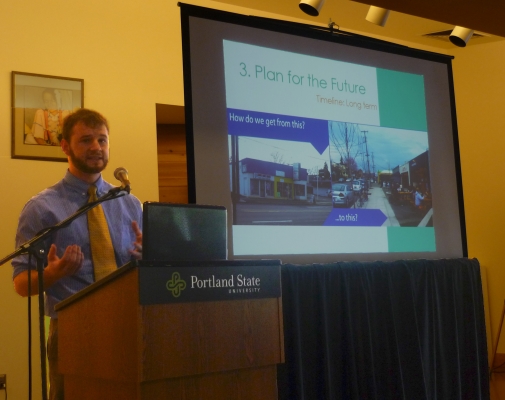PSU planning students re-imagine Lombard Street

Each year, Portland State University’s MURP, or Master’s of Urban and Regional Planning, program hosts a public presentation to showcase the work of its graduating master’s students. Students who graduate with a Master’s in Urban and Regional Planning spend the last two terms of their program collaborating on workshop projects, completing planning tasks for local clients or business organizations.
This year’s presentations took place on Wednesday, attended by a crowd of about a hundred PSU students, professors, MURP clients and community members. Six groups presented their projects. Some of the projects were transportation-focused, especially one titled "Lombard Re-Imagined."
Swift Planning Group, composed of members Kathryn Doherty-Chapman, Zef Wagner, Brian Hurley, Jake Warr, Rebecca Hamilton, and Jodi Jacobson-Swartfager, developed a plan to improve Lombard Street, a key transportation corridor in North Portland.
The challenge facing the group had to do with the many roles that Lombard street plays. The street is both an arterial throughway and a state highway. It is an overdimensional freight route, for trucks that are too big to go anywhere else in North Portland, and it has also been designated as a main street in Metro’s 2040 Growth Concept. The various roles of Lombard make it somewhat inhospitable to pedestrians, and this is something that many North Portland residents would like to see changed.
“Our approach to solving these problems was heavily centered on public outreach,” said Jake Warr, the group’s technical lead. “We were completely blown away by the enthusiasm and energy that the community has, and how much they want to see change, and how long people have wanted to see change on Lombard.”
The Swift group’s public outreach methods included walk-alongs (walking along with pedestrians and asking for feedback about the road), a highly successful online survey that collected about 800 responses, an open house that attracted about 100 guests, and going door-to-door to speak with business owners along Lombard, bringing along a Spanish interpreter so that they could also get the feedback of Spanish-speaking business owners.
The specific project area was a two-mile stretch between Martin Luther King, Jr. Blvd on the east end and Chautauqua Blvd on the west. This stretch includes a lot of businesses, residences, Lombard Transit Center, the I-5 crossing, schools, parks and other amenities.
It’s a difficult business environment. Most of the businesses that succeed there are auto-oriented, like fast-food restaurants and gas stations; not the pedestrian-oriented businesses the community wants to see. It is a relatively hostile pedestrian environment: there aren’t many crossings, traffic is loud; it’s just not a place a lot of people like to walk.
Based on the results of their public outreach surveys, the Swift group conceived four specific goals for Lombard, and they are producing a guidebook that will guide the community in how to achieve the changes they want to see. The goals are for Lombard to have ongoing support and stewardship by community members and organizations; to be a safe, accessible and functional transportation corridor that balances the needs of all users and all modes of travel; to incorporate pedestrian-oriented business districts that will be vibrant and serve the needs of the surrounding neighborhoods; and to have an attractive streetscape that encourages pedestrian activity. Swift Planning has worked closely with the Portland Bureau of Planning and Sustainability to make sure that their recommendations and report will inform the update of the comprehensive plan.
Other MURP groups that presented were:
Mill Street Community Planning, a group that came up with a strategy for community use of alleys along Foster Road;
Alderwood Community Planning, who developed anti- displacement strategies for low-income and culturally diverse residents in the Cully neighborhood;
Confluence Planning; who engaged with South Kelso residents to help the City of Kelso better understand the specific concerns of a marginalized local community;
5-9 Planning, with a downtown Oregon City Redevelopment Strategy;
and Align Planning, with a strategic plan for downtown Milwaukie.
These last two planning groups both focused on revitalizing the downtown districts, to make them into more vibrant areas and to attract future development and future residents.
